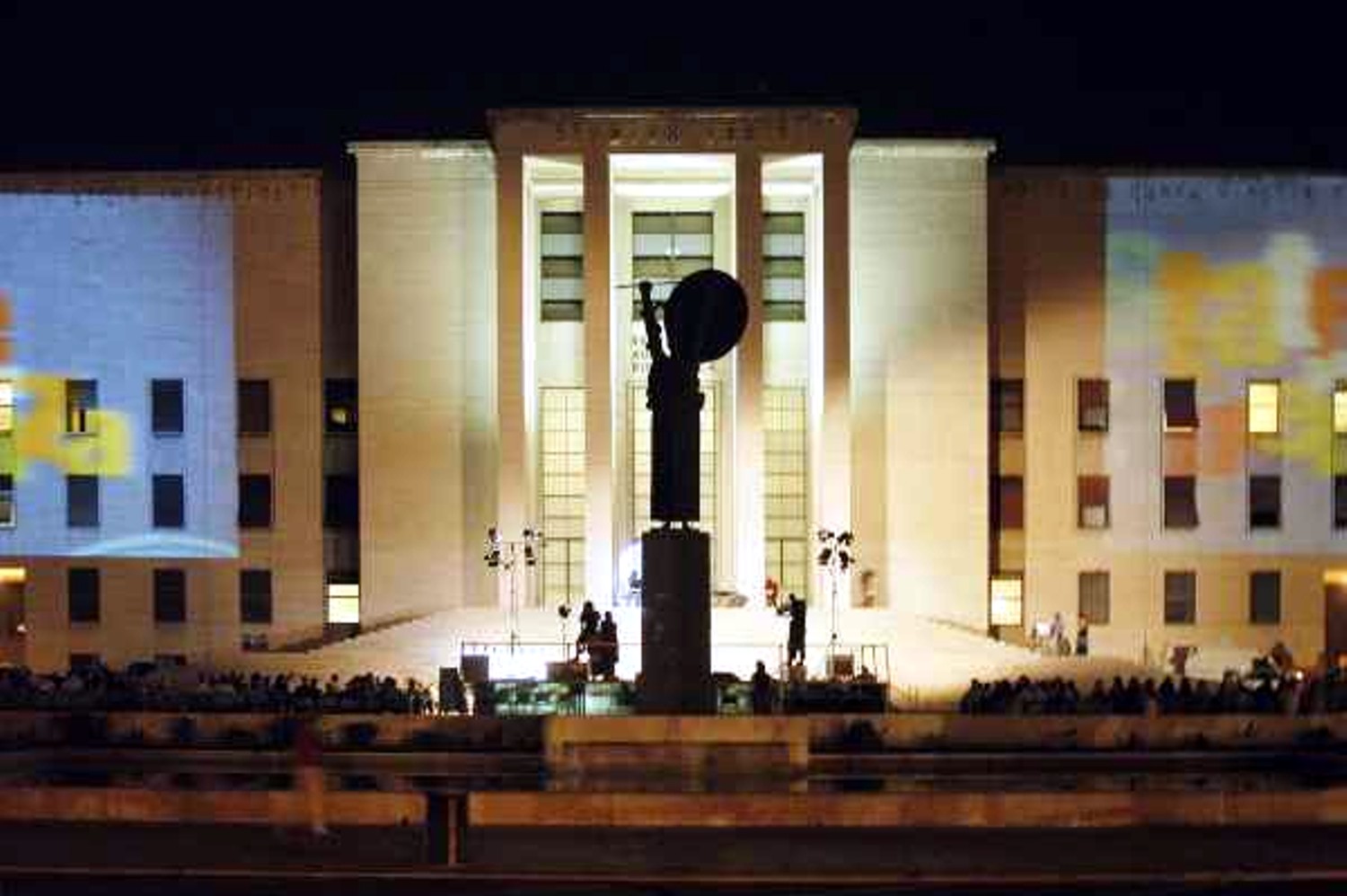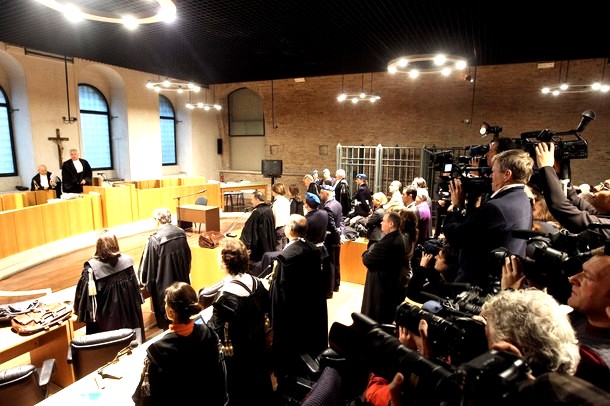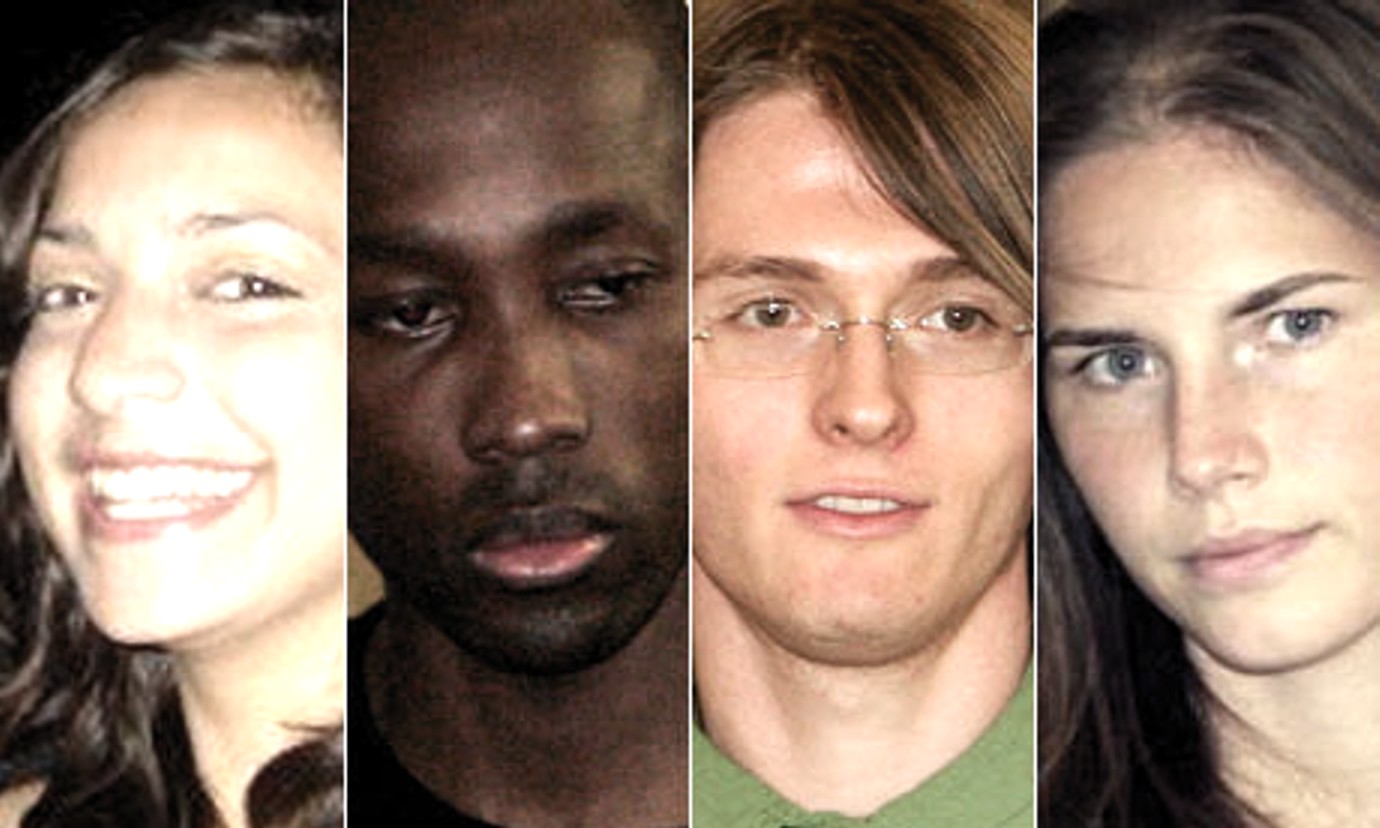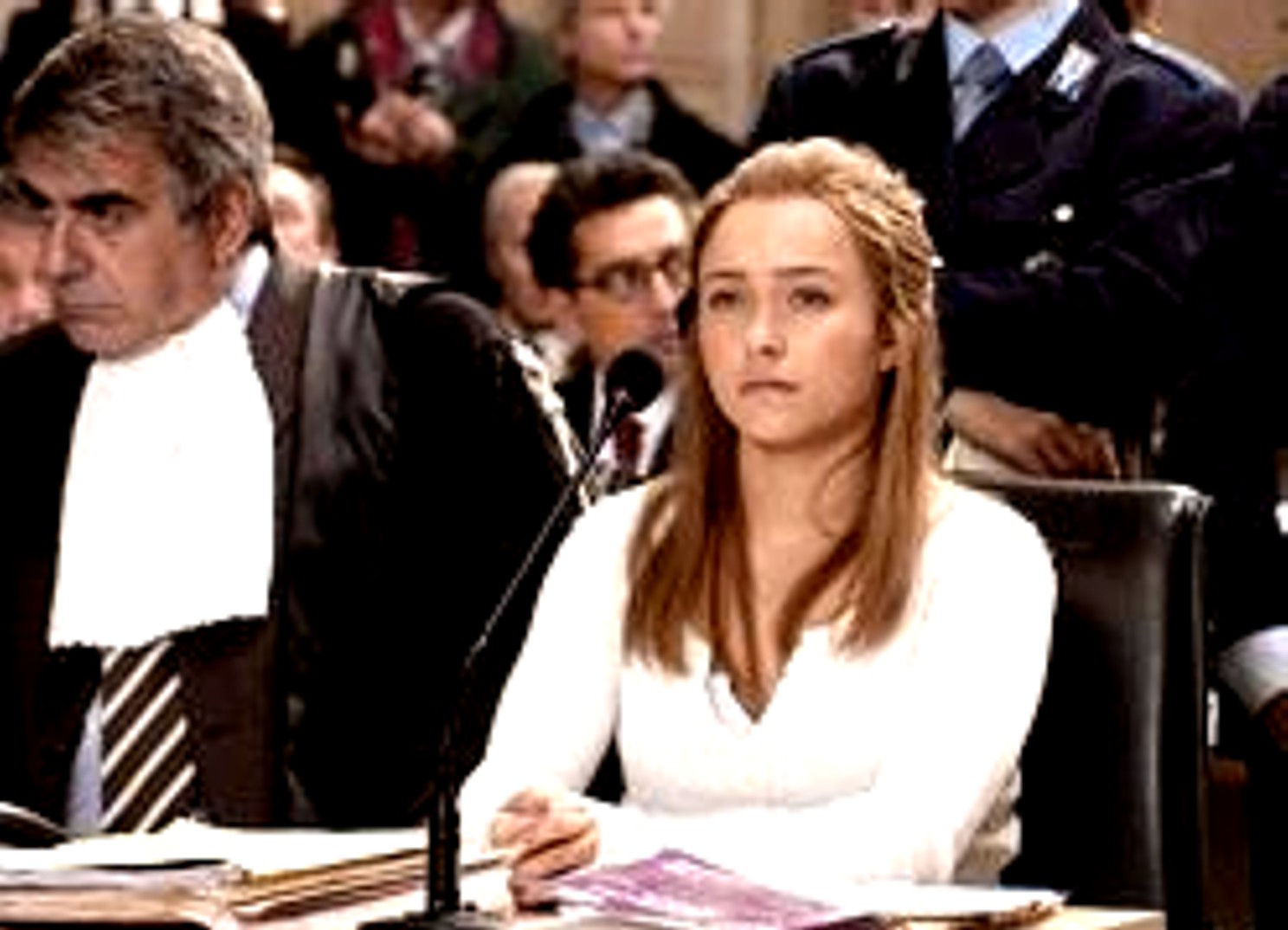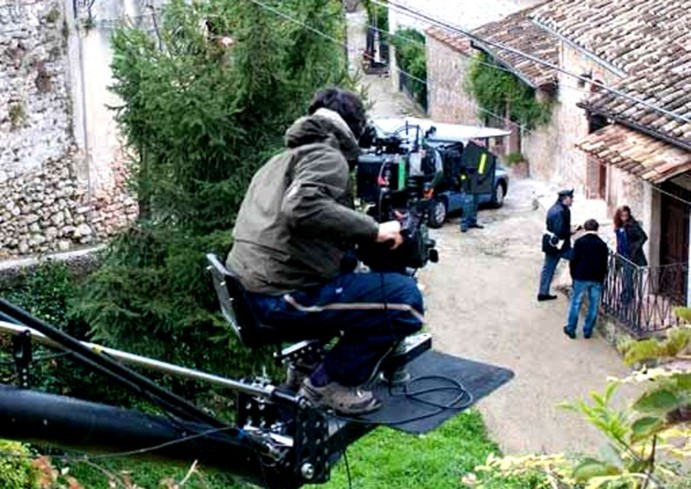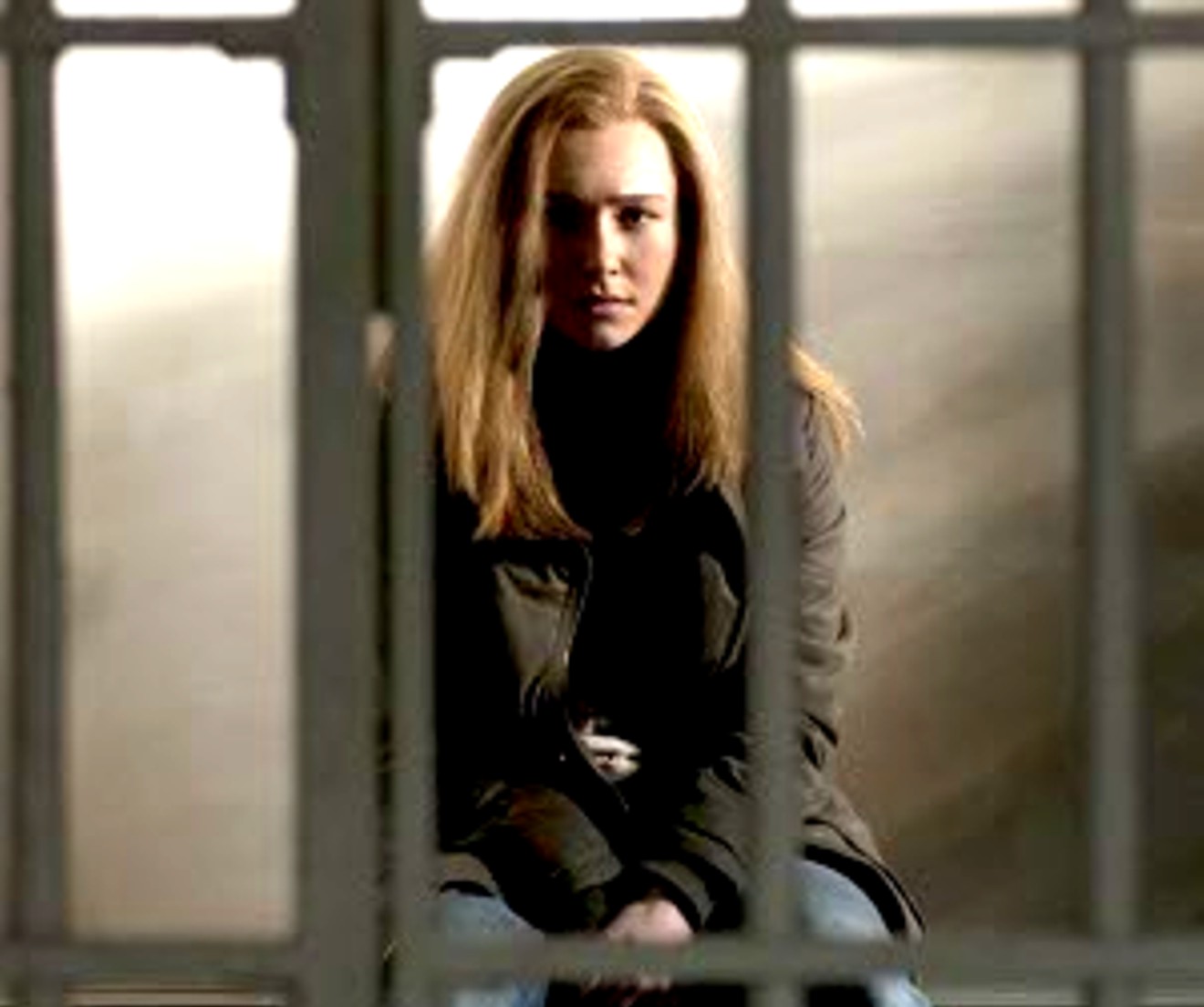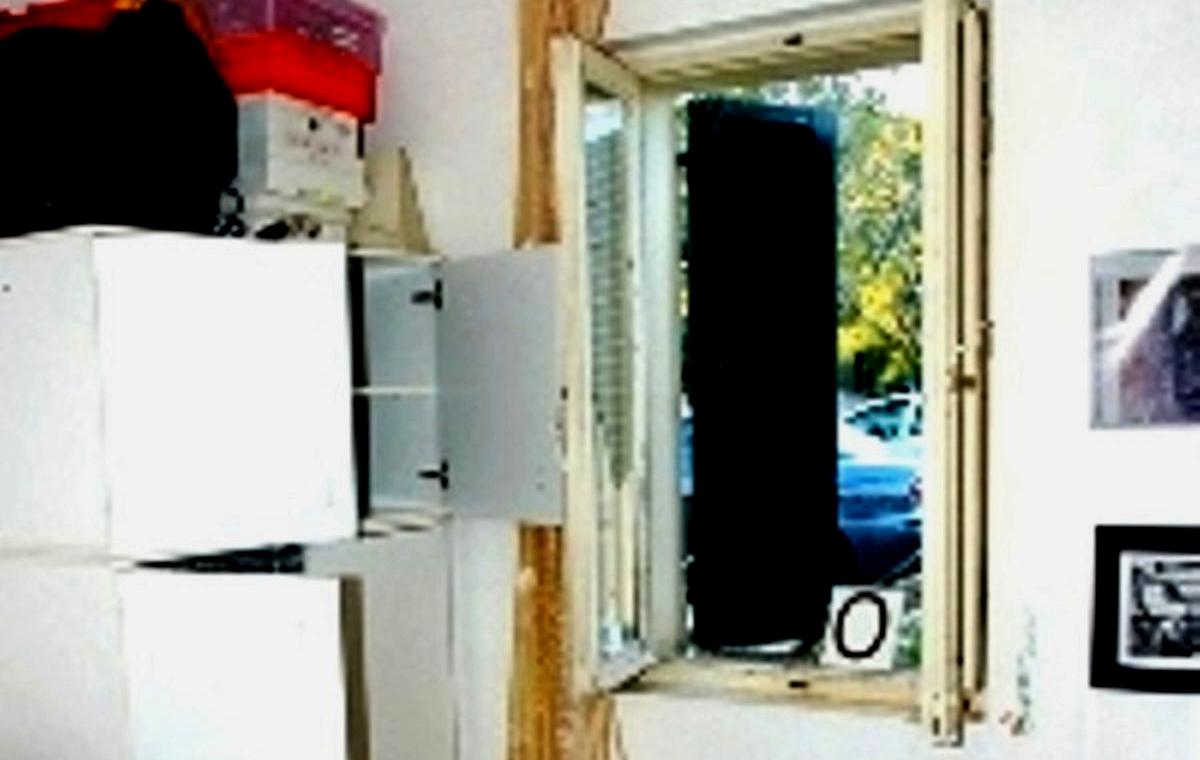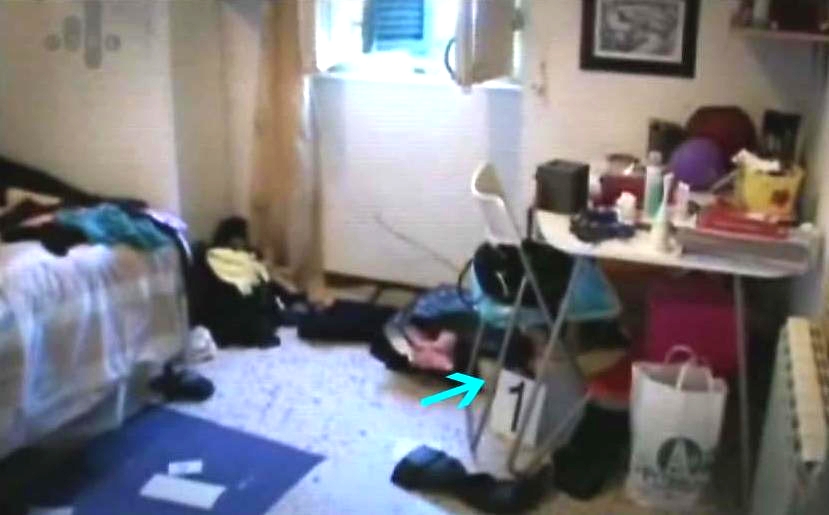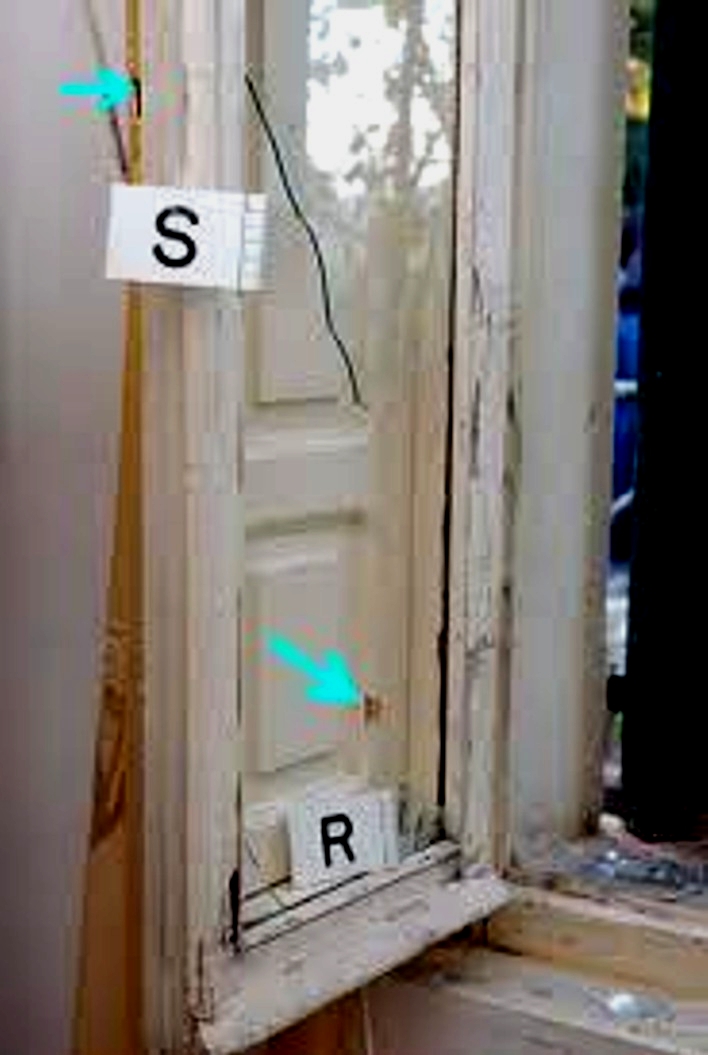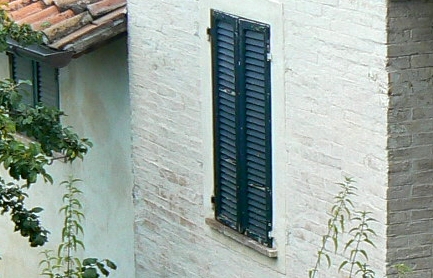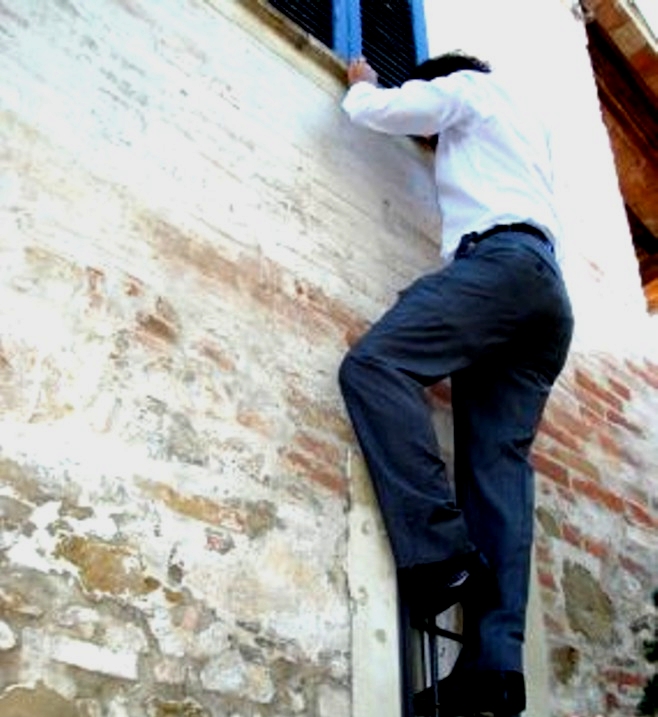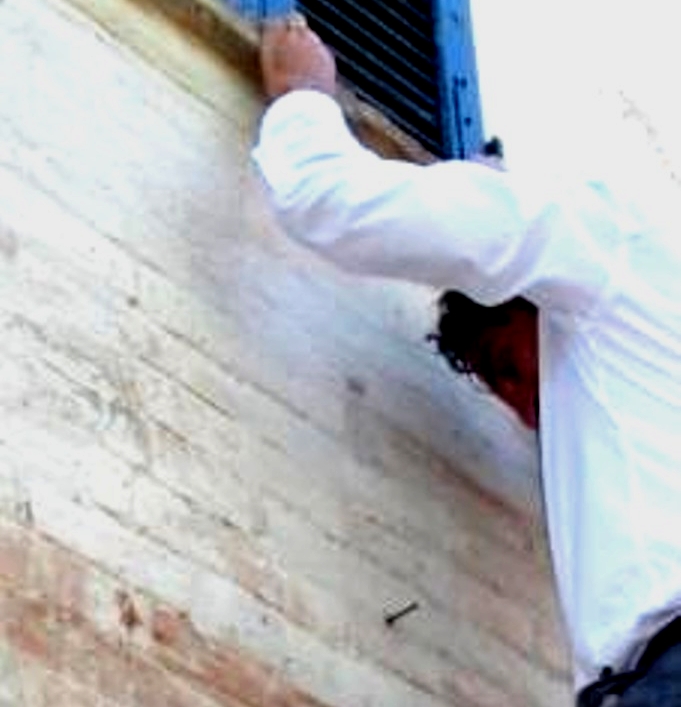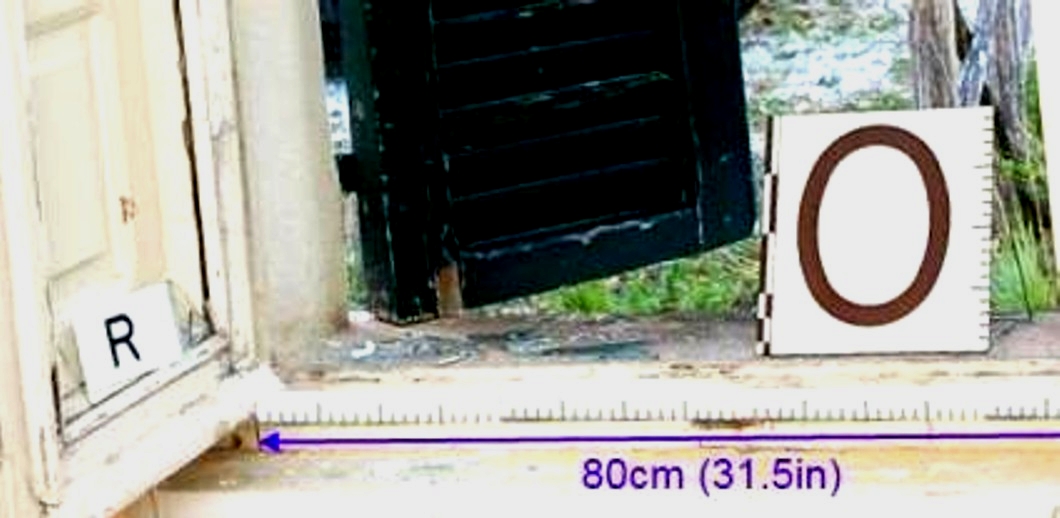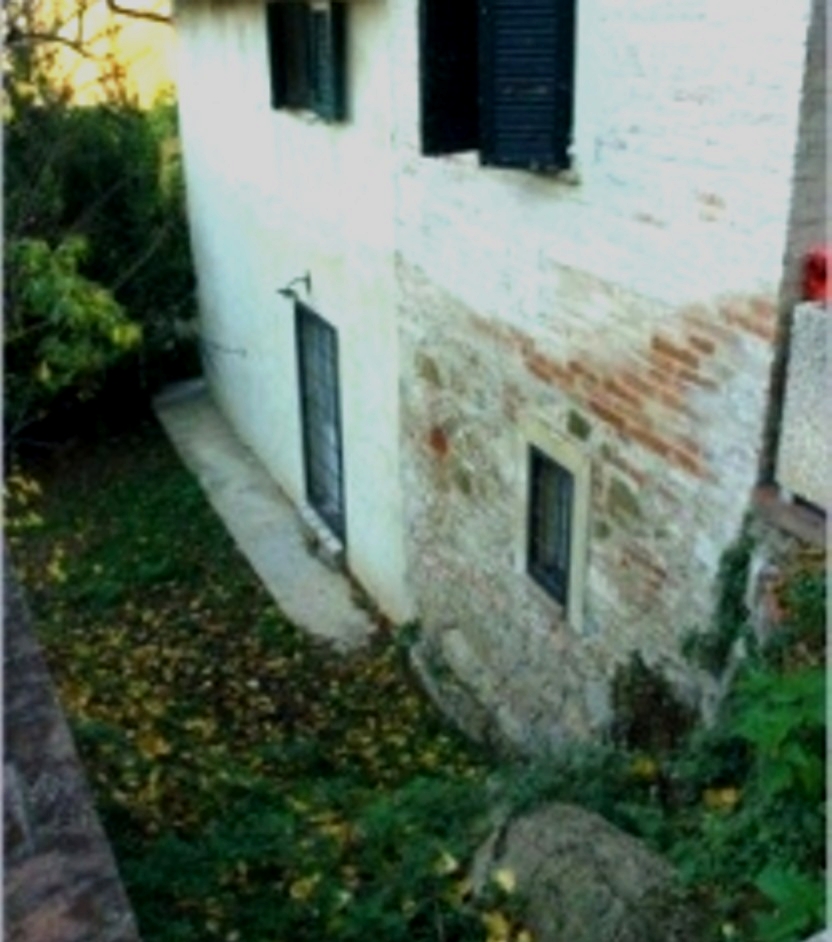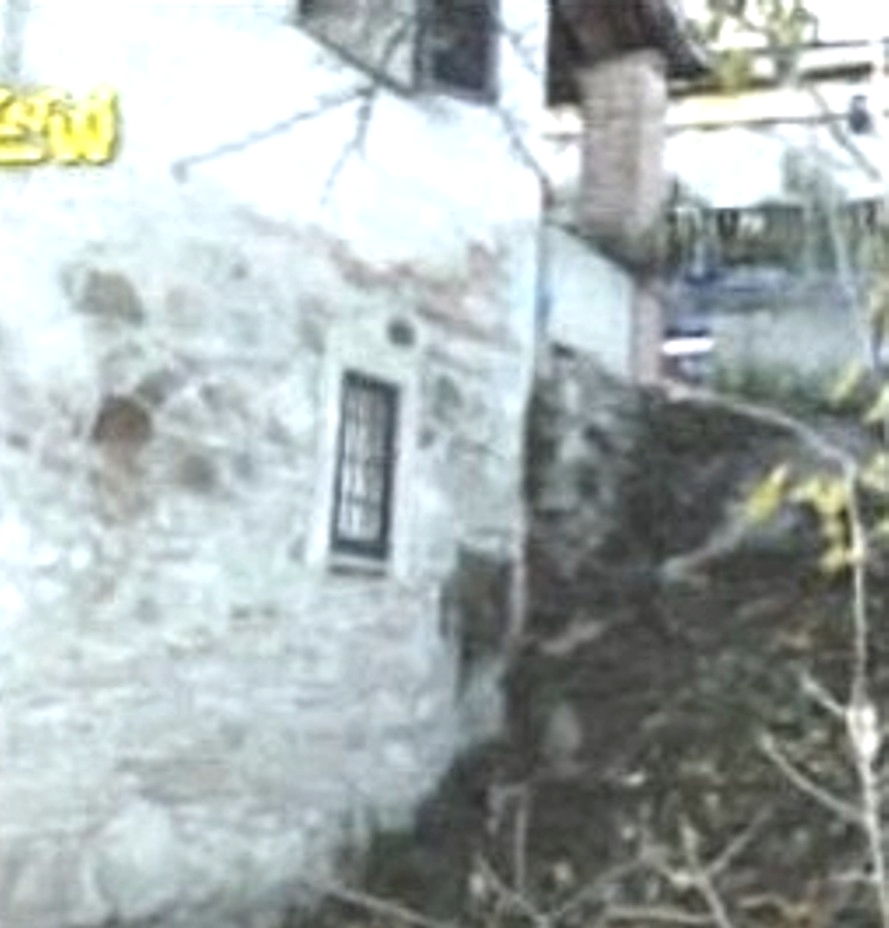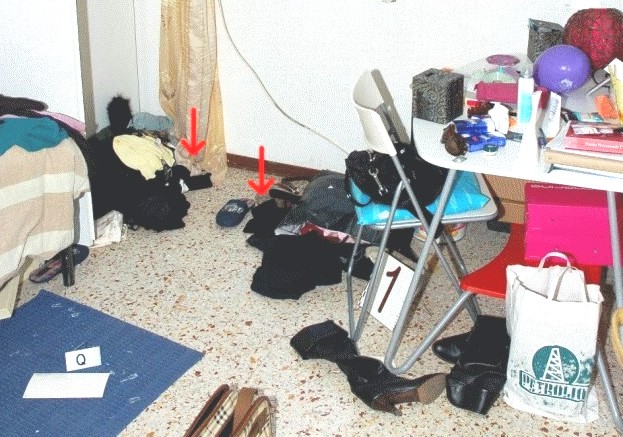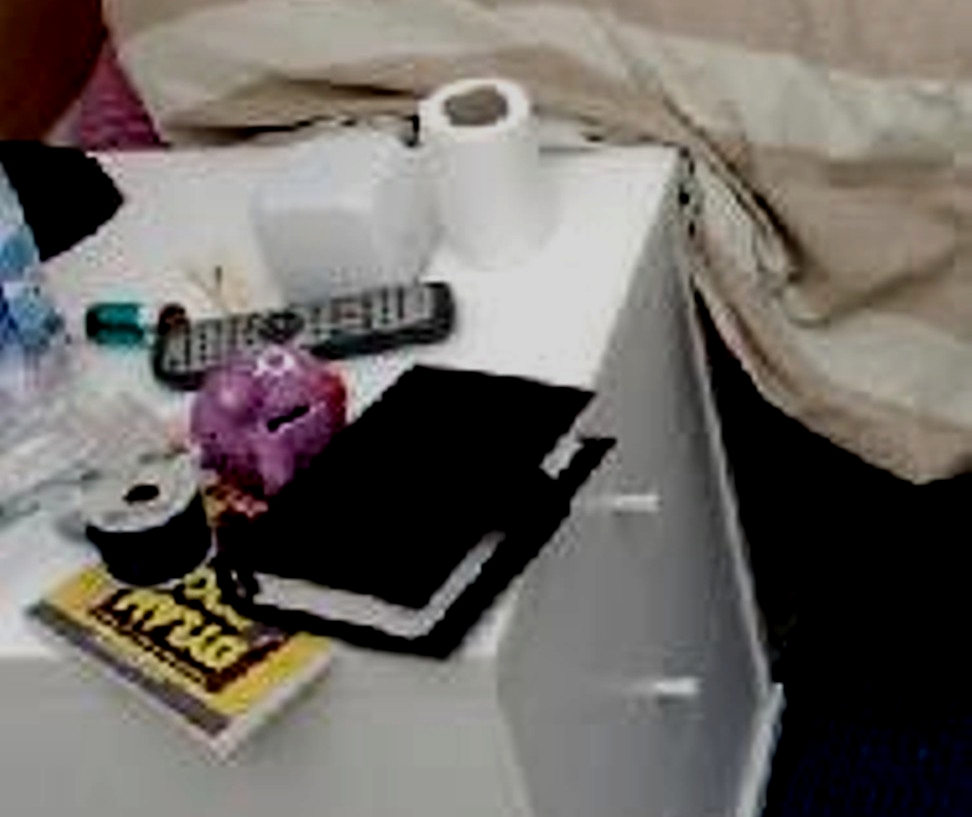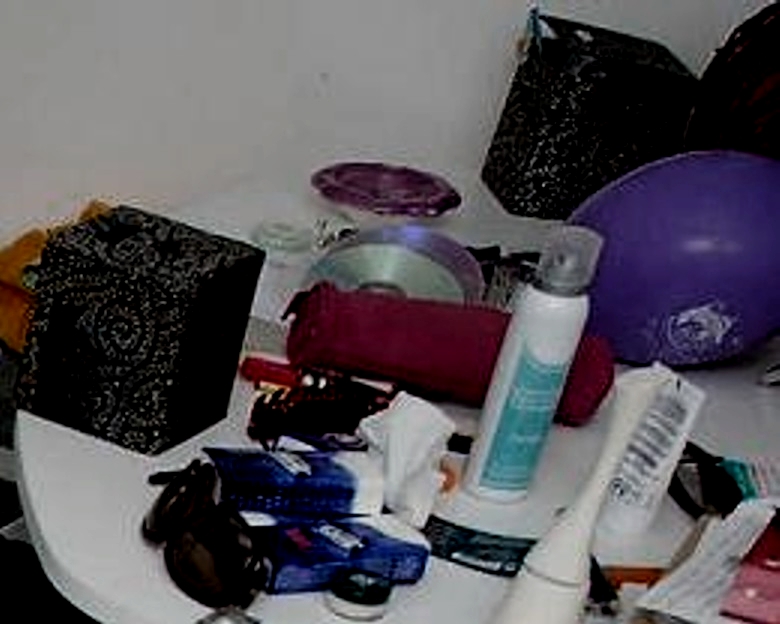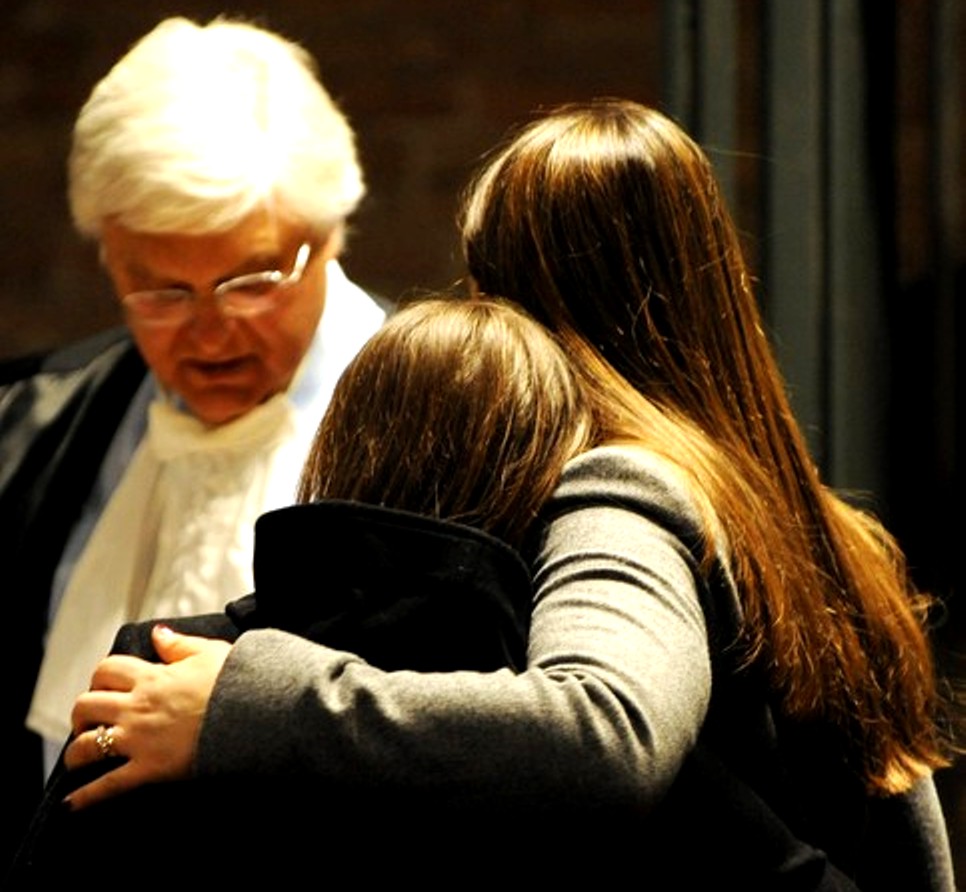
Category: Evidence & Witnesses
Tuesday, March 22, 2011
Limited Review Of The DNA Tests Agreed To By Judge Hellmann Are Now Underway In Rome
Posted by The Machine
[Amended by the Machine after his posted comment.]
Stefano Conti and Carla Vecchiotti of La Sapienza University in Rome (above) have begun the review of the DNA on the large double-DNA knife and the bra clasp under the eyes of expert witnesses.
Dr. Patrizia Stefanoni and Professor Giuseppe Novelli will be testifying on behalf of the prosecution.
Professor Novelli has an impressive CV. He is a highly regarded professor of biomedicine at Tor Vergata in Rome and director of the Centre of Excellence for Genomic Risk Assessment in Multifactorial and Complex Diseases. Professor Novelli is regarded as the “father of police forensics” in Italy.
If there had been any doubts about the validity of the DNA evidence against Amanda Knox and Raffaele Sollecito, he wouldn’t have agreed to testify for the prosecution.
A number of independent experts have already confirmed the validity of the DNA evidence at various court hearings.
There was an independent review of the forensic evidence in 2008. Dr. Renato Biondo, the head of the DNA unit of the scientific police, reviewed Dr. Stefanoni’s investigation and the forensic findings. He testified at Rudy Guede’s fast track trial in October 2008 and confirmed that all the forensic findings were accurate and reliable.
He also praised the work of Dr. Stefanoni and her team. “We are confirming the reliability of the information collected from the scene of the crime and at the same time, the professionalism and excellence of our work.”
Alberto Intini, the head of the Italian police forensic science unit, testified for the prosecution at the trial last year. He maintained that the crime scene had not been contaminated. He pointed out that unless contamination has been proved, it does not exist.
He also stated that the results of the tests showed that the investigation had been carried out correctly because there was not even one trace of any of the forensic technicians.
The Kercher family hired their own DNA expert, Professor Francesca Torricelli, and asked her to examine the DNA evidence.
Professor Torricelli is the Director of a genetic facility at Careggi University Hospital and has been working in genetics since 1976. She testified at Knox’s and Sollecito’s trial last year and she also confirmed Dr. Stefanoni’s findings.
She told the court that the significant amount of Sollecito’s DNA on Meredith’s bra clasp meant that it was unlikely that it was left by contamination. She also agreed with Dr. Stefanoni that Meredith’s DNA was on the blade of the double DNA knife.
Distinguished DNA expert and former Caribinieri General Luciano Garofano analysed the DNA and forensic evidence for the early 2010 book “Darkness Descending”.
He has more than 32 years of forensics experience and is a member of the American Academy of Forensic Sciences. He is considered by many as Italy’s top forensics expert. In his section of the book, he explains at length why he too thinks that Knox and Sollecito are guilty of Meredith’s murder.
Although General Garofano agrees with Dr. Renato Biondo and Alberto Intini that the scientific police did a good job, he thinks the police should have separated the plastic handle from the knife and checked for blood there because it often gathers in the grooves and recesses under the blade.
Stefano Conti has asked Judge Hellman for permission to take apart the handle of the knife.
The conclusions of the DNA retesting must be filed with Judge Hellman’s court no later than May 9 and they will be discussed at the appeal hearing on May 21.
Retesting of the DNA was always a high-stakes gamble for the defense teams and could prove to be game-over for Knox’s and Sollecito’s appeal in a single stroke.
On the other hand, the prosecution has little to worry about either way, as the balance of the evidence is so massive.
Sunday, March 13, 2011
Fifth Appeal Hearing: Testimony On Club Closings And Buses Leaves Credibility Of Eyewitness Intact
Posted by Peter Quennell
The shot above from the front of the School for Foreigners is of Piazza Grimana.
Click for a larger image. You can see the square with the benches at extreme left and right, and at rear the basketball court where Rudy Guede played. At the back there at the far right are the stone stairs down which Knox and Sollecito may have entered the park.
The many traversing buses mostly stop right in front here and they would block most of that view.
It is hard for us to see the defense witness testimony from six witnesses - one nightclub owner apparently refused to show - that several clubs were closed and several buses not running as any big deal.
In this post below we mentioned that Judge Micheli at Rudy Guede’s trial in October 2008 had accepted the testimony of Mr Curatolo because he said it was the night before the police descended on Meredith’s house and the square.
Judge Masse’s court also used this as a pointer to Mr Curatolo’s credibility and the Supreme Court of Cassation in denying Guede’s ten appeal grounds also endorsed the testimony as good.
Here now is a repeat of our report on Mr Curatolo’s day in court by our man in the court at the time, StewartHome2000, almost precisely two years ago (29 March 2009).
He is a fixture in Perugia. He is a vagrant that spends most of his time hanging around Corso Garibaldi (the street where Sollecito lived) and Piazza Grimana (the piazza in front of the School for Foreigners within eyeshot of the gate of Meredith’s house on Via della Pergola).
The crowd murmured as he was helped in by court assistants, uncleaned and dressed in an old jacket and winter knit hat. His skin was dark against his long un-groomed white hair, beard and mustache. But once he opened his mouth, you knew that this guy was no slouch. He spoke clearly, concisely and directly, and was very certain of what he saw.
His testimony never swayed and was consistent even under cross examination. In short, his appearance was one thing, his articulate convincing testimony was another.
He stated that he has been a regular hobo (for lack of a better term) around that part of Perugia for about 8-9 years. He testified that he was in Piazza Grimani around 9:30-10:00pm when he saw across the piazza two people, a man and a woman. He described them as a couple from the way they were sitting next to one another.
He was asked to describe them and he turned and looked at Amanda, just a few feet away, and said calmly, “it was her”, and then looked at Sollecito and said “and him.” He stated that having been in that area he had seen them before separately, but this was the first time he saw them together. But he was certain it was them.
He said also that, although he did not watch them all the time, he did see them again “poco prima di mezzanotte” or “just before midnight” at the same place. He originally said that they were there from 9:30 through midnight, but clarified that they were there at 9:30-10:00pm and may have left around 11-11:30 and then returned to be there just before midnight.
After midnight, he left the piazza to go to the park and sleep.
The next day, he arrived at his faithful piazza around 12:00pm, and eventually, around 1:30 or so, he saw the carabinieri pass by, and the police and crime scene staff, and stated that he watched them at the scene, including the CSI people dressed in the full-white suits.
Under cross-examination, Sollecito’s lawyer Ms Buongiorno may have thought she had an easy target. But in fact he held up extremely well. She asked, “how could you possibly know it was 9:30?” and he responded “Because the sign next to the piazza has a digital clock. I look at it often to check the time”.
He stated that “when I sat on the bench to read I looked at my watch and it was just before 9:30pm”¦.and I saw them shortly afterwards.” He said he knows what he saw, and he saw those two! No more questions.
Buses and nightclubs were not even mentioned in this comprehensive report. They were not even brought up by the defenses to rebut Mr Curatolo’s timeline two years ago.
The defenses again seem to be clutching at straws.
Friday, March 11, 2011
Fifth Appeal Hearing: What Will Be On The Agenda Tomorrow In Court
Posted by Peter Quennell
Scheduled for tomorrow are seven witnesses for Sollecito’s defense, which is trying to prove that the eyewitness in the park, Mr Curatolo, got his dates wrong.
One of the ways in which Mr Curatolo identified the night on which he says he watched Knox and Sollecito sitting and talking in the park and periodically peering in the direction of the gate of Meredith’s house was by the presence of some buses.
They may have been the buses which climb up the very narrow Via Ulise Rocchi from the square to some clubs further up. However many, many other buses also pass through that square.
The defense hopes to land its first blow on the prosecution’s case by showing that on the night those nightclub buses weren’t there - that the clubs were closed that night for the holiday, and so the nightclub buses were nowhere to be seen.
Is this crucial? We think not. Mr Curatolo is useful in establishing a possible timeline for the night, but not for much more than that. The prosecution have never given the slightest hint that they believe anything like their whole case hangs on him.
And in Rudy Guede’s brief trial in October 2008 Judge Micheli accepted Mr Curatolo’s testimony as valid because he said he saw Knox and Sollecito on the night before all the police descended on Meredith’s house and the square.
Judge Micheli examines the evidence of Antonio Curatolo. He says that although Curatolo mixes up his dates in his statement, he does have a fix on the night he saw Amanda and Raffaele in Piazza Grimana sometime around 11:00 to 11:30pm. Curatolo is certain it was the night before the Piazza filled up with policemen asking if anyone had seen Meredith.
In his evidence, he says they came into the square from the direction of Via Pinturicchio and kept looking towards the cottage at Via della Pergola from a position in the square where they could see the entrance gate.
Judge Micheli reasons in his report that their arrival from Via Pinturicchio ties in with the evidence from Nara Capazzali that she heard someone run up the stairs in the direction of that street. He also reasons that they were likely watching the cottage to see if Meredith’s scream had resulted in the arrival of the police or other activity.
Acceptance of his testimony is already endorsed by two appeals courts, including the Supreme Court of Cassation, and all the decisions and all the evidence from all three courts now get ported into the Knox-Solleito appeal.
You can see photos of the square here and the view down to the gate of Meredith’s house here.
Monday, February 28, 2011
Andrea Vogt: Supreme Court Report Highlights Amanda Knox Mention To Mom She Was There
Posted by Peter Quennell
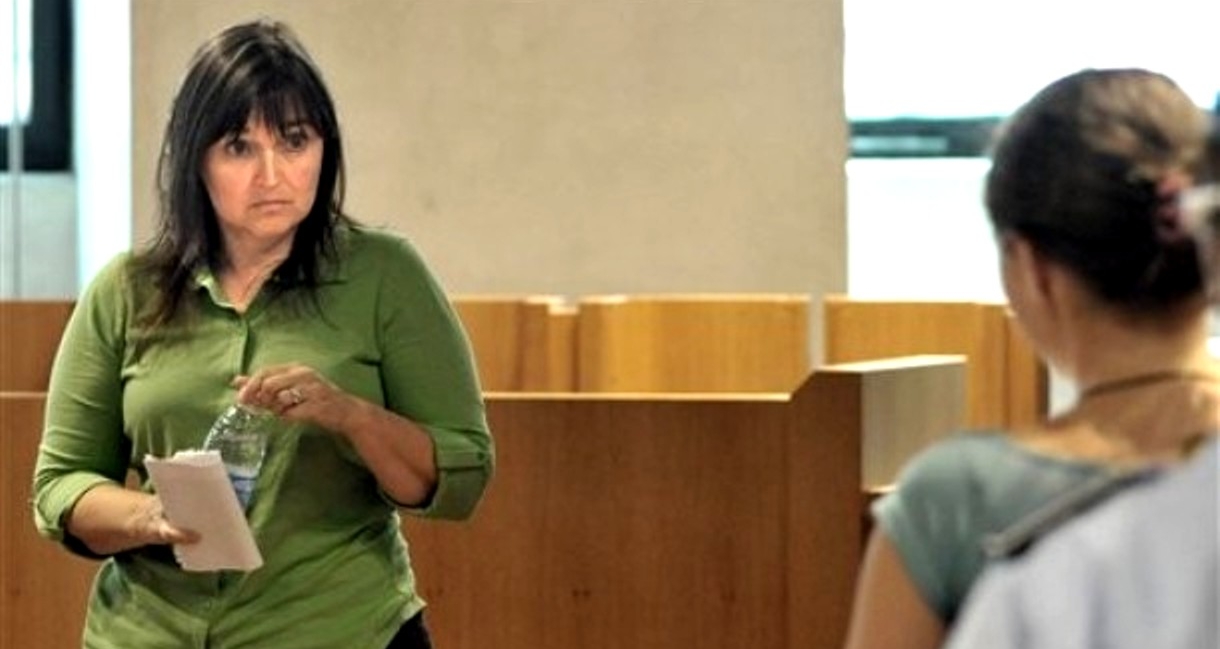
[Above: Amanda Knox and her mother in courtroom when Edda Mellas testified 19 July 2009]
Andrea Vogt in the Seattle PI translates from the Cassation Report described in our two previous posts.
A sentencing report just released by the highest Italian appeals court sheds new light on why so many Italian judges have maintained Amanda Knox was involved in her roommate’s murder.
The document, among others, cites a conversation Knox had with her parents while under surveillance during a prison visit in which she said “I was there,” apparently referring to the night of the murder.
Amanda Kox’s remark was recorded at Capanne Prison and was long public knowledge, but that the Supreme Court listed it among other evidence of involvement in this report is significant. The report summarises what is the evidence against all three, especially that against Rudy Guede.
The court…said that based on the 43 wounds to Kercher’s body (and the time it would take to inflict them) that it was… probable that Guede and two others forcibly held Kercher down, threatened, taunted and eventually fatally stabbed her.
The Court’s quoted language is extremely hard and gives a sense that the judges were appalled. The Court’s report has been out in Italy for over four days now - but the Seattle PI’s is the first extensive US or UK media summary.
The US and UK media have a pretty consistent habit of ignoring these inconvenient reports.
Saturday, February 26, 2011
Very Hard Language Of Supreme Court In Rejecting Guede Appeal, Confirming Three Did It
Posted by Peter Quennell
The report of the Supreme Court of Cassation released on Thursday was foreshadowed in content in our post of 17 December:
Rudy Guede’s appeal is rejected on all ten grounds. His appeal grounds were ugly and dishonest and he has no further appeal. He will serve his 16 years, with maybe some time off, for being a savage willing party to the cruel stupid murder of Meredith.
Rudy Guede will go down in infamy for his sex crime against a defenseless victim, for being a party to a taunting torturing knife attack, for claiming Meredith invited him in for consensual sex, and for not calling for help for Meredith and maybe saving her life while it was still possible.
Cassation continues the fine Italian court tradition in this case of taking a firm and unblinking position, and for being utterly oblivious to the vile over-the-top campaign of Curt Knox, Edda Mellas and David Marriott which may now haunt Amanda Knox all of her life.
What really caught the Italian media’s attention and made this the second most widely reported development in the case after the Amanda Knox-Raffaele Sollecito verdict was the icy hard language, the pure contempt for the depraved pack attack, the total rejection of all Guede’s stories, including his oft-repeated and totally unbelievable claim that Meredith invited him in and wanted love-making, and the court’s conclusion once again that the evidence methodically described in the Micheli Report overwhelmingly proves that THREE perpetrators took part in the crime.
The Court of Cassation in this report made clear that Knox and Sollecito are not already formally nominated as the other two perpetrators and it does wait the referral of the outcome of the present appeal in Perugia. But unless the defense witnesses Alessi and Aviello can indeed convince Judge Hellman’s appeal court that Guede attacked Meredith with friends or that some other people entirely carried out the attack, there seems no way out for them.
The court also indicated that it considered the motive of the attack on Meredith to be frivolous, which is precisely what the prosecution claims in the current Perugia appeal as grounds for rejecting Massei’s mitigating circumstances, and for increasing Knox’s and Sollecito’s prison sentences to life terms.
This post of a month ago further explains Knox’s and Sollecito’s almost insurmountable problems.
The written report from Cassation on that December 2010 decision on Guede’s final appeal (due soon), plus Judge Micheli’s Sentencing Report for Rudy Guede of January 2009, plus all that associated evidence, now gets automatically ported by law straight into Knox’s and Sollecito’s appeal.
Judge Micheli took a hard line toward Rudy Guede, and he sentenced him to 30 years. He also remanded Knox and Sollecito to trial, and his report explains the basis for that remand.
Judge Micheli’s remorseless and tightly argued report (see summaries below) very comprehensively backed up his decisions. (Later reductions in sentence were automatic and they flowed from the terms of Guede’s short-form trial, and some controversial mitigating circumstances advanced by Massei for Knox and Sollecito.)
The prosecution’s appeal against the Knox and Sollecito sentences argues that the acceptance of mitigating circumstances by the Massei court should be thrown out, and that Knox and Sollecito should be subjected to a longer sentence. Remember that even in the case of Alessi’s wife, who was not even present when he beat the kidnapped baby to death, she received a sentence of 30 years.
So here is how it is stacking up:.
For the prosecution, four courts including the Supreme Court of Cassation have ruled that three people participated in the crime against Meredith, plus all of the evidence from both the Guede and Knox Sollecito trials now comes in, plus the prosecution is appealing for tougher sentences, which seems well justified based on precedents.
And for the defenses? Will they now feel they have no choice but to put Knox or Sollecito or Alessi or Aviello or for that matter Rudy Guede on the stand as a last-ditch manoeuvre?
Hard to see what further they have to lose.
Tuesday, February 22, 2011
Open Questions: An Experienced Trial Lawyer Recommends How To Zero In On the Truth
Posted by SomeAlibi
Welcome
If you’ve come to this website because of the Lifetime movie of Meredith Kercher and Amanda Knox, then welcome.
Like all of us who come to this case, you have one key question: did they do it? The movie you’ve just watched is equivocal on that matter and perhaps didn’t help you at all.
On the internet, you will find people who are passionate in their defence of Amanda Knox and Raffaele Sollecito and you will find people who are passionate in their support of the prosecution.
My own arrival
Placing my own cards on the table here: as a twenty-plus year practising trial lawyer, I am firmly a part of that latter camp. But it wasn’t always that way.
It was information ““ evidence ““ that changed my views. What became very clear to me, early on, was that very few people in the English-speaking world are aware of anywhere near all of the evidence in this case.
I had thought I had grasped the core of the case, but I did not. The case is deep and complex and like many criminal cases, the complete facts behind it have been only sketchily reported in the media. The movie you may have just watched only skirts the real reasons the jury convicted.
The unanimous jury
I am sure that we all agree that no jury, in any murder case, given the awesome responsibility of adjudicating on (young) people’s lives for a multi-decade period of imprisonment, condemns people lightly.
It should be a matter of logic that the evidence presented against the accused must have been deep and satisfied the 6 lay jurors and 2 judges on the case for them to pronounce that huge judgement. That doesn’t mean that there couldn’t be the possibility of a mistrial, but clearly the evidence presented must have been substantial.
In this, we’ve already hit the first problem. Some supporters of Amanda Knox and Raffaele Sollecito will tell you there’s no evidence against them.
This is patently silly. No jury ever convicts people and sends them to prison for 24 plus years without being quite convinced of the case against them. Miscarriages of justice do happen, but the idea that there is “no evidence” can be summarily dismissed.
The only question is whether the evidence is sufficient, true and accurate.
The voluminous evidence
So is the evidence enough to convict beyond a reasonable doubt? The six lay jurors and two professional judges thought so, clearly. What you realise, when you come to the facts of the case, is that the evidence is based not around a single key event but on multiple points.
It can be astonishing to realise that the case is based not only on DNA evidence but also on cellphone evidence and computer records and further yet on multiple conflicting and contradicting versions of what happened that night from the mouths of the accused, not to mention falsely accusing an innocent man of responsibility for murder causing his incarceration.
The wealth of evidence is actually extremely unusual. It goes way beyond the quite similar Scott Peterson case.
The Massei Sentencing Report
What is absolutely new to the English speaking legal world is that the reasoning for the conviction can be read in an extremely detailed 440+ page report online. Bilingual posters at the Perugia Murder File Forum many of whom who are also key posters at TJMK translated the entire document into English over several months last year.
It was my privilege to play an extremely small part in that work. People from four different continents with backgrounds in forensic science, law, academia and a host of other disciplines participated.
You can read an effective executive summary by clicking on the Massei Report link at top here and reading the conclusions from page 388 onwards:
The Knox PR campaign
If you are new to this case, you will likely be shocked how much evidence there is against the convicted parties. Amanda Knox’s family have spent over $1m and involved a professional PR agency called Gogerty Marriot to suggest otherwise in the English-speaking media.
You might wonder why an innocent person needs a million dollar PR campaign on their part. Make yourself a coffee and read the conclusions of the judge’s report. It will take you about 15 minutes. Up until you read this report, almost everything you watch, hear and read is PR spin and is quite deliberately positioned to make you believe there is no case.
When you complete it, I believe you will have a very different take. That 15 minutes could change your ideas about everything you thought you knew about the murder of Meredith Kercher.
Now for a quick tour of the evidence.
Some of the points of evidence
Consider as you read it what is your own possible explanation for each of the following:
- the fact that the wound pattern and the reconstruction of the attack, each presented at trial in extensive closed-court sessions, showed this absolutely had to be a pack attack;
- the DNA of Raffaele Sollecito on Meredith’s bra-clasp in her locked bedroom;
- the almost-entire naked footprint of Raffaele on a bathmat that in *no way* fits that of the other male in this case - Rudy Guede;
- the fact that Raffaele’s own father blew their alibi that they were together in Raffaele’s flat at the time of the killing with indisputable telephone records;
- the DNA of Meredith Kercher on the knife in Raffaele’s flat which Raffaele himself sought to explain as having been from accidentally “pricking” Meredith’s hand in his written diary despite the fact Meredith had never been to his flat (confirmed by Amanda Knox);
- the correlation of where Meredith’s phones were found to the location of Raffaele Sollecito and Rudy Guedes’s flats;
- the computer records which show that no-one was at Raffaele’s computer during the time of the murder despite him claiming he was using that computer;
- Amanda’s DNA mixed with Meredith Kercher’s in five different places just feet from Meredith’s body;
- the utterly inexplicable computer records the morning after the murder starting at 5.32 am and including multiple file creations and interactions thereafter all during a time that Raffaele and Amanda insist they were asleep until 10.30am;
- the separate witnesses who testified on oath that Amanda and Raffaele were at the square 40 metres from the girls’ cottage on the evening of the murder and the fact that Amanda was seen at a convenience store at 7.45am the next morning, again while she said she was in bed;
- the accusation of a completely innocent man by Amanda Knox again and again when under no pressure which she insisted on putting in writing;
- the fact of Knox’s claim that she was aggressively interrogated for days, although she did not even have the status of a witness, and signed every page of every typed record of her mild, mundane and quite limited questionings;
- the fact that during Knox’s very unconvincing performance on the witness stand in July 2009 she admitted she was treated well and was not abused;
- the fact that when Amanda Knox rang Meredith’s mobile telephones, ostensibly to check on the “missing” Meredith, she did so for just three seconds - registering the call but making no effort to allow the phone to be answered in the real world
- the knife-fetish of Raffaele Sollecito, and his formal disciplinary punishment for watching animal porn at his university so far from the wholesome image portrayed;
- the fact that claimed multi-year kick-boxer Raffaele apparently couldn’t break down a flimsy door to Meredith’s room when he and Amanda were at the flat the morning after the murder but the first people in the flat with the police who weren’t martial artists could;
- the extensive hard drug use of Sollecito as told on by Amanda Knox;
- the fact that Amanda knew details of the body and the wounds despite not being in line of sight of the body when it was discovered;
- the lies of Knox on the witness stand in July 2009 about how their drug intake that night (“one joint”) is totally contradicted by Sollecito’s own contemporaneous diary;
- the fact that after a late evening’s questioning, Knox wrote a 2,900 word email home which painstakingly details what she said happened that evening and the morning after that looks *highly* like someone committing to memory, at 3.30 in the morning, an extensive alibi;
- the fact that both Amanda and Raffaele both said they would give up smoking dope for life in their prison diaries despite having apparently nothing to regret;
- the fact that when Rudy Guede was arrested, Raffaele Sollecito didn’t celebrate the “true” perpetrator being arrested (which surely would have seen him released) but worried in his diary that a man whom he said he didn’t know would “make up strange things” about him despite him just being one person in a city of over 160,000 people;
- the fact that both an occupant of the cottage and the police instantly recognised the cottage had not been burgled but had been the subject of a staged break-in where glass was *on top* of apparently disturbed clothes;
- the fact that Knox and Sollecito have feuded quite publicly ever since November 2007 and have shown far more anger toward one another than either has ever shown toward Guede;
- the fact that Knox and Sollecito both suggested each other might have committed the crime and Sollecito TO THIS DATE does not agree Knox stayed in his flat all the night in question;
- the fact of the bizarre behaviour of both of them for days after the crime;
- the fact that cellphone records show Knox did not stay in Sollecito’s flat but had left the flat at a time which is completely coincidental with Guede’s corroborated presence near the girl’s flat earlier in the evening;
- the fact that Amanda Knox’s table lamp was found in the locked room of Meredith Kercher in a position that suggested it had been used to examine for fine details of the murder scene in a clean up;
- the unbelievable series of changing stories made up by the defendants after their versions became challenged;
- Knox’s inexplicable reaction to being shown the knife drawer at the girl’s cottage where she ended up physically shaking and hitting her head despite being joyful earlier at the police station.
In conclusion
This list is not exhaustive. It goes”¦ on”¦ and on”¦ and on”¦ And yet, those supporting Knox will tell you that’s all made up, all coincidental.
Really? Does the weight of all that evidence sound made up to you?
If so, it must be the most over-rigged criminal case in the history of crime. Unlikely beyond all and any reasonable doubt.
The judge’s report explains why the jury found the defendants guilty. I truly expect you will be astonished at the amount of evidence if all you’ve done is watched a film or read a few press reports.
For any questions thereafter, please join us and post them on truejustice.org or perugiamuderfile.org . You’ll find here a host of good people who are all working on a totally volunteer basis in memory of the only victim of this crime.
Meredith Susanna Cara Kercher. RIP.
Tuesday, February 01, 2011
Explaining The Massei Report: A Visual Guide To The Faked Break-In Via Filomena’s Window
Posted by pat az
1. Post Overview
Cross-posted from my own website on Meredith’s case at the kind invitation of TJMK.
The Massei Report on the trial and sentencing of Amanda Knox and Raffaele Sollecito looks into whether or not a break-in is supported by the evidence available in the room with the broken window.
It concludes that the broken window and room in disarray - Filomena’s bedroom - are an “artificial representation”, ie. that the break-in was faked. After seven pages of review of the evidence, the Massei Report states:
“the situation of disorder in Romanelli’s room and the breaking of the window pane constitute an artificial representation created in order to orient the investigations towards a person who, not having the key to the front door, was supposed to have entered through the previously broken window and then effected the violent acts on Meredith which caused her death.
What follows is a look at the comments in the Massei report compared with crime scene and other photos. All quotes are from the English translation prepared by unpaid volunteers at PerugiaMurderFile.org. The section on the scenes in the bedroom begins on page 47 and continues to page 55. Some sentences in the paragraphs below have been omitted for brevity, and can be read in full in the original.
2. Knox Finds The Scene
Then (Amanda) went into another room and noticed that the window had been broken and that there was glass inside. She told these things to her and the other girls present. Then she related that she had gone back to Raffaele’s house and had rung Filomena.
I)n one of the telephone calls to Romanelli, Amanda spoke of that smashed window and of the possibility that someone could have entered the house through the broken place; she said this also in the telephone call to 112 and in the first declarations to the Postal Police.
Also in the e-mail of November 4, 2007, sent by Amanda to 25 people in the US, she hypothesises that a burglar could have entered the house and says she looked around to see if anything was missing.
Filomena Romanelli, disturbed by this phone call, had rung Amanda back without receiving a reply and when, a little later, she had succeeded in speaking to Amanda, Amanda had told her that in her room (i.e., in Ms. Romanelli’s room) the windowpane was broken, everything was in a mess, and that she should come back home.
Filomena Romanelli had ascertained from a quick check of her room, even though (it was) in a complete mess with the windowpane broken, that nothing was missing.
It must be held that when Filomena Romanelli left the house in via della Pergola, she had pulled the [interior] shutters towards the interior of her room, although she did not think that she had actually closed them; furthermore, because they were old and the wood had swelled a bit, they rubbed on the windowsill; to pull them towards the room it was necessary to use some force (“they rubbed on the windowsill”); but in this way, once they had been pulled in, as Romanelli remembered doing, they remained well closed by the pressure of the swelled wood against the windowsill.
It cannot be assumed - as the Defence Consultant did - that the [interior] shutters were left completely open, since this contradicts the declarations of Romanelli, which appear to be detailed and entirely likely, considering that she was actually leaving for the holiday and had some things of value in her room; already she did not feel quite safe because window-frames were in wood without any grille.
Also, the circumstance of the [interior] shutters being wide open does not correspond to their position when they were found and described by witnesses on November 2, and photographed (cf. photo 11 already mentioned).
Now, for a rock to have been able to break the glass of the window without shattering the outside shutters, it would have been necessary to remove the obstacle of the shutters by opening them up.
Consequently, since the shutters had been pulled together and their rubbing put pressure on the windowsill on which they rested, it would have first been necessary to effect an operation with the specific goal of completely opening these shutters.
The failure to find any instrument suitable for making such an opening (one cannot even see what type of instrument could be used to this end) leads one to assume that the wall would have to have been scaled a first time in order to effect the complete opening of the shutters, in order to enable the burglar to aim at the window and smash it by throwing a large stone - the one found in Romanelli’s room.
He would then have to have returned underneath Romanelli’s window for the second climb, and through the broken glass, open the window (balanced on his knees or feet on the outside part of the windowsill), otherwise he would not have been able to pass his arm through the hole in the glass made by the stone) and reach up to the latch that fastened the window casements, necessarily latched since otherwise, if the casements had not been latched, it would not have been necessary to throw a rock at all, but just to open the shutters and climb inside.
The “climber” would also need to rely on the fact that the [interior] shutters were not actually latched, and also that the “scuri” ]blackout blind] had not been fastened to the window-frame to which the broken pane was attached; otherwise it would not have been possible to open them from the outside; nor would it have been possible, even breaking the glass, to make a hole giving access to the house, since if these inner panels had been closed, they would have continued to provide an adequate obstacle to the possibility of opening the window, in spite of the broken pane.
This scenario appears totally unlikely, given the effort involved (going twice underneath the window, going up to throw the stone, scaling the wall twice) and taking into account the uncertainty of success (having to count on the two favourable circumstances indicated above), with a repetition of movements and behaviours, all of which could easily be seen by anyone who happened to be passing by on the street or actually coming into the house.
But beyond these considerations, there are other elements which tend to exclude the possibility that a burglar could have entered the house through the window of Romanelli’s room.The double climb necessary to attain the height of three and a half metres would have left some kind of trace or imprint on the wall, especially on the points on the wall that the “climber” would have used to support his feet, all the more as both the witnesses Romanelli and Marco Zaroli gave statements indicating that the earth, on that early November evening, must have been very wet (..6) (p50)
In fact, there are no visible signs on the wall, and furthermore, it can be observed that the nail ““ this was noted by this Court of Assizes during the inspection ““ remained where it was: it seems very unlikely that the climber, given the position of that nail and its characteristics, visible in the photo 11, did not somehow “encounter” that nail and force it, inadvertently or by using it as a foothold, causing it to fall or at least bend it. (p50)
The next fact to consider is that the pieces of glass from the broken pane were distributed in a homogeneous manner on the inside and outside parts of the windowsill, without any displacement being noted or any piece of glass being found on the ground underneath the window.
This circumstance, as confirmed also by the consultant Pasquali, tends to exclude the possibility that the rock was thrown from outside the house to create access to the house through the window after the breaking of the pane. The climber, in leaning his hands and then his feet or knees on the windowsill, would have caused at least some piece of glass to fall, or at least would have been obliged to shift some pieces of glass in order to avoid being wounded by them.
Instead, no piece of glass was found under the window, and no sign of any wound was seen on the pieces of glass found in Romanelli’s room. It can moreover be observed that the presence of many pieces of glass on the outside part of the windowsill increases the probability of finding some small pieces of glass on the ground underneath, since there seems to be no reason that so many pieces of glass would all stop just at the edge of the windowsill without any of them flying beyond the edge and falling down to the garden below. (p51 & 52)
On this subject it is also useful to recall that at the hearing of April 23, 2009, the witness Gioia Brocci mentioned above declared that she had observed the exterior of the house, paying particular attention to the wall underneath the window with the broken pane, the window of the room then occupied by Filomena Romanelli.
She said: “We observed both the wall”¦underneath the window and all of the vegetation underneath the window, and we noted that there were no traces on the wall, no traces of earth, of grass, nothing, no streaks, nothing at all, and none [39] of the vegetation underneath the window appeared to have been trampled; nothing” (p. 142 declarations of Gioia Brocci). (51)
This situation, like all the other glaring inconsistencies, is adequately and satisfactorily explained if one supposes that the rock was thrown from the inside of the room, with the two shutters pulled inwards so that they blocked the pieces of glass from falling to the ground below. Once the glass had been broken from inside, the rock was set down at some place in the room, and the shutters were pushed towards the outside, being thus opened from within the room. (p51)
But the fact that all this was in fact just a simulation, a staging, can be deduced from further circumstances. From the photos taken by the personnel of the Questura (photos 47 to 54 and 65 to 66) one can perceive an activity which appears to have been performed with the goal of creating a situation of obvious disorder in Romanelli’s room, but does not appear to be the result of actual ransacking, true searching for the kind of valuable objects that might tempt a burglar.
The drawers of the little dresser next to the bed were not even opened (photo 51 and declarations of Battistelli who noted that Romanelli was the one who opened the drawers, having found them closed and with no sign of having been rifled: see p. 66 of Battistelli’s declarations, hearing of Feb. 6, 2009).
The objects on the shelves in photo 52 appear not to have been touched at all; piles of clothes seem to have been thrown down from the closet (photo 54) but it does not seem that there was any serious search in the closet, in which some clothes and some boxes remained in place without showing any signs of an actual search for valuable items that might have been there (photo 54).
It does not appear that the boxes on the table were opened (photo 65) in a search for valuable items. And indeed, no valuable item (cf. declarations of Romanelli) was taken, or even set aside to be taken, by the ““ at this point we can say phantom ““ burglar.
What has been explained up to now thus leads to the assertion that the situation of disorder in Romanelli’s room and the breaking of the window pane constitute an artificial representation created in order to orient the investigations towards a person who, not having the key to the front door, was supposed to have entered through the previously broken window and then effected the violent acts on Meredith which caused her death.
Footnotes
(...1) The Massei Report in English is readable and downloadable via the link at the top of this page.
(..2) The consultant for the defence actually assumed that this had been done; in his exhibit, he assumed that the shutters were not present in front of the window
(..3): “if the shutters were closed, he could not have passed through, that is obvious”, cf. declarations of the consultant for the defence, Sergeant Francesco Pasquali, p. 22 hearing July 3, 2009.
(..4): (the window in Romanelli’s room is located at a height of more than three and a half metres from the ground underneath, cf. photo 11 from the relevant dossier)
(..5):,which are the wooden panels [scuri=non-louvered shutters in interior of room] that usually constitute the outer side (or the inner, depending on the point of view) of the window [attached to the outer edge of the inner side of the window-frame]
Monday, January 24, 2011
The Limited DNA Reviews - What We Believe Are The Hard Facts On The Double DNA Knife
Posted by ViaDellaPergola
Repeat of my December post as the knife is again back in sharp focus.
The wild claims of the conspiracy theorists have morphed back and forth. But the facts remain that Italy has a fine DNA lab system and Dr Stefanoni is internationally respected - and she had no vested interest in a particular outcome.
Sollecito coolly explained that Meredith’s DNA SHOULD be on the blade of the knife because he pricked her while he was cooking a fish at his place. She had never ever been to his place - in fact, she had only set eyes on him once or twice, very briefly, and had certainly not eaten his fish.
But Sollecito STILL lets that highly incriminating statement stand - one that is enough to secure a conviction in an American court all by itself. Sollecito never retracted or explained it. Why not? Why not?
The truth, obviously, is worse. Very, very much worse.
Saturday, January 22, 2011
Fourth Appeal Hearing: Updates On Today’s Court Hearing Which Is Mainly Procedural
Posted by Peter Quennell
Above: Sapienza University is the largest European university and the oldest of Rome’s three state-funded universities.
- At noon Italian time ANSA reported that the two DNA experts from Sapienza University have been given 90 days to do their retesting. They will begin their review on Feb. 9, conclude by May 9 and report their findings to the court on May 21.
- The witness in the square on the night who said he saw Sollecito and Knox, Antonio Curatolo, will be re-examined. This is at the prosecution’s request, not at the defenses’.
- The DNA experts have asked to break open the handle of the knife they are asked to retest. If Meredith’s blood is found to have seeped into the handle, by itself that will be case closed and verdict confirmed. Decision on hold.
- The examinations will be carried out in the presence of representatives of all parties. Among them will be Dr. Patrizia Stefanoni, the technical director of the forensic laboratory that conducted the original DNA investigations.
- The prosecution requested Rudy Guede as a witness and that too was put on hold. Yet another shot across the bows of the defense. If Alessi or Aviello are put on the stand then Guede will also be there to heatedly rebut them.
- The next appeal hearings scheduled by the court of appeal have been set for 12 and 26 March, and April 16 and May 21. May 21 is when the DNA experts will report back so just three days for examination of witnesses.
Judge Hellman is allowing no defense fishing expeditions, and he is giving the prosecution full latitude. Good reason for Giulia Boingiorno not to be in court: her baby was delivered today in Rome. We like her and wish her and the baby well.
Below, images of the two court-appointed DNA experts and of Amanda Knox. The Reuters caption says her lawyers are consoling her. Chris Mellas’s remarks later made it sound like the family is already trying to let her down gently.
.
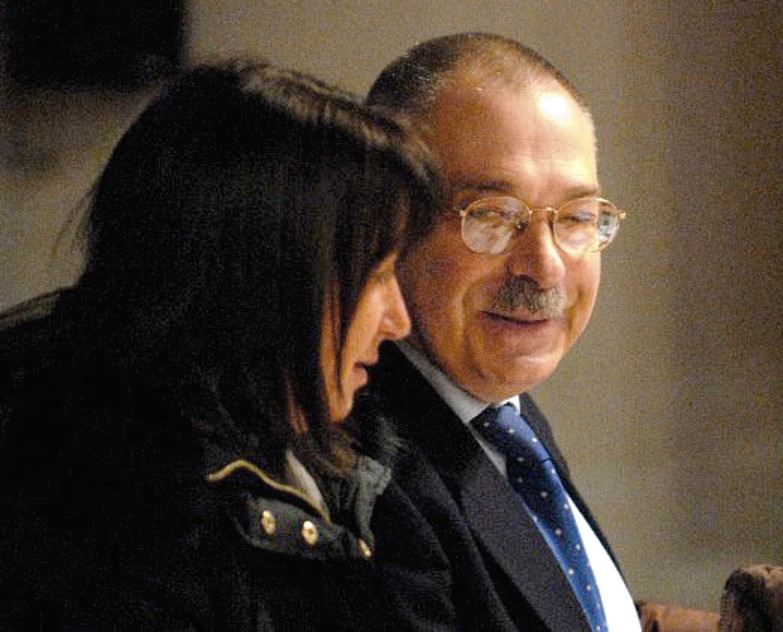
The Fourth Appeal Hearing Today Saturday: The Main Items On The Court’s Agenda
Posted by Peter Quennell
Not very much drama is expected. This hearing is mainly organizational.
The mood of the defense lawyers will be interesting to watch. Also whether Sollecito lawyer Giulia Bongiorno is a show or a no-show. And we may find out if the possible defense witnesses Mario Alessi and Luciano Aviello will actually testify.
Two DNA experts nominated by Judge Hellman at the last appeal hearing on 11 December for the genetics testing of the bra clasp and the knife will appear and be sworn in and charged with their assignment.
Stefano Conti and Carla Vecchiotti of La Sapienza University in Rome will be asked how long they believe they will need and it is expected that they will ask for two to three months.
And the court will establish a timetable for the testimony of several new defense witnesses who may challenge one or two components of Antonio Curatolo’s statement. Nick Pisa bizarrely mis-reports on this in the Daily Telegraph:
He had told the court he remembered the night “clearly” as he saw student revellers queuing up to catch buses to nightclubs on the outskirts of the city.
However defence lawyers have established that he could not have seen the students, as the night Meredith was murdered was a bank holiday with venues being shut and no buses running.
Have established that he could not have seen the students? Really? There were other buses than the disco buses running that night. Students were definitely around.
If prisoners Mario Alessi or Luciano Aviello are indeed put on the firm list to testify that’ll be a pretty sure sign that the defenses are really clutching at straws, as in each case their known claims are contradicted by dozens of evidence points .
The prosecution has interviewed both of them and those interviews have not been made public. Here are more wrong and seemingly irrelevant claims bizarrely reported by Nick Pisa.
Retired British university professor David Anderson, who lives near Perugia and who has taken an interest in the case, said: “The conviction of Amanda and Raffaele is scandalous as neither has the psychological profile of a killer.
“The investigation was flawed from the beginning with many mistakes being made and there is no DNA, no real motive, no weapon and no credible witnesses at all.”

